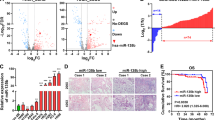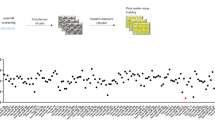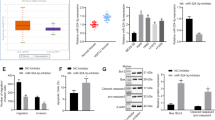Abstract
The tumor suppressor p53, nuclear factor-κB (NF-κB) and reactive oxygen species (ROS) have crucial roles in tumorigenesis, although the mechanisms of cross talk between these factors remain largely unknown. Here we report that miR-506 upregulation occurs in 83% of lung cancer patients (156 cases), and its expression highly correlates with ROS. Ectopic expression of miR-506 inhibits NF-κB p65 expression, induces ROS accumulation and then activates p53 to suppress lung cancer cell viability, but not in normal cells. Interestingly, p53 promotes miR-506 expression level, indicating that miR-506 mediates cross talk between p53, NF-κB p65 and ROS. Furthermore, we demonstrated that miR-506 mimics inhibited tumorigenesis in vivo, implicating that miR-506 might be a potential therapeutic molecule for selective killing of lung cancer cells.
This is a preview of subscription content, access via your institution
Access options
Subscribe to this journal
Receive 50 print issues and online access
$259.00 per year
only $5.18 per issue
Buy this article
- Purchase on Springer Link
- Instant access to full article PDF
Prices may be subject to local taxes which are calculated during checkout







Similar content being viewed by others
References
Bartel DP . MicroRNAs: genomics, biogenesis, mechanism, and function. Cell 2004; 116: 281–297.
Inui M, Martello G, Piccolo S . MicroRNA control of signal transduction. Nat Rev Mol Cell Biol 2010; 11: 252–263.
Linzer DI, Levine AJ . Characterization of a 54 K dalton cellular SV40 tumor antigen present in SV40-transformed cells and uninfected embryonal carcinoma cells. Cell 1979; 17: 43–52.
Harris SL, Levine AJ . The p53 pathway: positive and negative feedback loops. Oncogene 2005; 24: 2899–2908.
Bommer GT, Gerin I, Feng Y, Kaczorowski AJ, Kuick R, Love RE et al. p53-mediated activation of miRNA34 candidate tumor-suppressor genes. Curr Biol 2007; 17: 1298–1307.
He L, He X, Lim LP, de Stanchina E, Xuan Z, Liang Y et al. A microRNA component of the p53 tumour suppressor network. Nature 2007; 447: 1130–1134.
Vogelstein B, Lane D, Levine AJ . Surfing the p53 network. Nature 2000; 408: 307–310.
Dey A, Verma CS, Lane DP . Updates on p53: modulation of p53 degradation as a therapeutic approach. Br J Cancer 2008; 98: 4–8.
Vazquez A, Bond EE, Levine AJ, Bond GL . The genetics of the p53 pathway, apoptosis and cancer therapy. Nat Rev Drug Discov 2008; 7: 979–987.
Karin M, Greten FR . NF-kappaB: linking inflammation and immunity to cancer development and progression. Nat Rev Immunol 2005; 5: 749–759.
Karin M . Nuclear factor-kappa B in cancer development and progression. Nature 2006; 441: 431–436.
Basseres DS, Baldwin AS . Nuclear factor-kappaB and inhibitor of kappaB kinase pathways in oncogenic initiation and progression. Oncogene 2006; 25: 6817–6830.
Sethi G, Sung B, Aggarwal BB . Nuclear factor-kB activation: From bench to bedside. Exp Biol Med 2008; 233: 21–31.
Perkins ND . Integrating cell-signalling pathways with NF-kappa B and IKK function. Nat Rev Mol Cell Biol 2007; 8: 49–62.
Li F, Sethi G . Targeting transcription factor NF-kappa B to overcome chemoresistance and radioresistance in cancer therapy. Biochim Biophys Acta 2010; 1805: 167–180.
Ramalingam SS, Owonikoko TK, Khuri FR . Lung cancer: new biological insights and recent therapeutic advances. CA Cancer J Clin 2011; 61: 91–112.
Trachootham D, Alexandre J, Huang P . Targeting cancer cells by ROS-mediated mechanisms: a radical therapeutic approach? Nat Rev Drug Discov 2009; 8: 579–591.
Toyokuni S, Okamoto K, Yodoi J, Hiai H . Persistent oxidative stress in cancer. FEBS Lett 1995; 358: 1–3.
Visconti R, Grieco D . New insights on oxidative stress in cancer. Curr Opin Drug Discov Dev 2009; 12: 240–245.
Montero AJ, Jassem J . Cellular redox pathways as a therapeutic target in the treatment of cancer. Drugs 2011; 71: 1385–1396.
Cheng YH, Liu XJ, Zhang SO, Lin Y, Yang J, Zhang CX . MicroRNA-21 protects against the H2O2-induced injury on cardiac myocytes via its target gene PDCD4. J Mol Cell Cardiol 2009; 47: 5–14.
Ebi H, Sato T, Sugito N, Hosono Y, Yatabe Y, Matsuyama Y et al. Counterbalance between RB inactivation and miR-17-92 overexpression in reactive oxygen species and DNA damage induction in lung cancers. Oncogene 2009; 28: 3371–3379.
Zhang R, Peng Y, Wang W, Su B . Rapid evolution of an X-linked microRNA cluster in primates. Genome Res 2007; 17: 612–617.
Perkins ND . The diverse and complex roles of NF-kappa B subunits in cancer. Nat Rev Cancer 2012; 12: 121–132.
Wang CY, Mayo MW, Korneluk RG, Goeddel DV, Baldwin AS . NF-kappa B antiapoptosis: Induction of TRAF1 and TRAF2 and c-IAP1 and c-IAP2 to suppress caspase-8 activation. Science 1998; 281: 1680–1683.
Jaruga P, Zastawny TH, Skokowski J, Dizdaroglu M, Olinski R . Oxidative DNA-base damage and antioxidant enzyme-activities in human lung-cancer. FEBS Lett 1994; 341: 59–64.
Mates JM, Sanchez-Jimenez FM . Role of reactive oxygen species in apoptosis: implications for cancer therapy. Int J Biochem Cell Biol 2000; 32: 157–170.
Keyse SM, Tyrrell RM . Heme oxygenase is the major 32-kDa stress protein-induced in human-skin fibroblasts by UVA radiation, hydrogen-peroxide and sodium arsenite. Proc Natl Acad Sci USA 1989; 86: 99–103.
Lavin MF, Gueven N . The complexity of p53 stabilization and activation. Cell Death Differ 2006; 13: 941–950.
Suzuki HI, Yamagata K, Sugimoto K, Iwamoto T, Kato S, Miyazono K . Modulation of microRNA processing by p53. Nature 2009; 460: 529–U111.
Dai Y, Rahmani M, Dent P, Grant S . Blockade of histone deacetylase inhibitor-induced RelA/p65 acetylation and NF-kappaB activation potentiates apoptosis in leukemia cells through a process mediated by oxidative damage, XIAP downregulation, and c-Jun N-terminal kinase 1 activation. Mol Cell Biol 2005; 25: 5429–5444.
Meylan E, Dooley AL, Feldser DM, Shen L, Turk E, Ouyang C et al. Requirement for NF-kappaB signalling in a mouse model of lung adenocarcinoma. Nature 2009; 462: 104–107.
Basseres DS, Ebbs A, Levantini E, Baldwin AS . Requirement of the NF-kappa B subunit p65/RelA for K-Ras-induced lung tumorigenesis. Cancer Res 2010; 70: 3537–3546.
Streicher KL, Zhu W, Lehmann KP, Georgantas RW, Morehouse CA, Brohawn P et al. A novel oncogenic role for the miRNA-506-514 cluster in initiating melanocyte transformation and promoting melanoma growth. Oncogene 2012; 31: 1558–1570.
Tazawa H, Tsuchiya N, Izumiya M, Nakagama H . Tumor-suppressive miR-34a induces senescence-like growth arrest through modulation of the E2F pathway in human colon cancer cells. Proc Natl Acad Sci USA 2007; 104: 15472–15477.
Mateescu B, Batista L, Cardon M, Gruosso T, de Feraudy Y, Mariani O et al. miR-141 and miR-200a act on ovarian tumorigenesis by controlling oxidative stress response. Nat Med 2011; 17: 1627–U1144.
Yang D, Sun Y, Hu LM, Zheng H, Ji P, Pecot CV et al. Integrated analyses identify a master microrna regulatory network for the mesenchymal subtype in serous ovarian cancer. Cancer Cell 2013; 23: 705–705.
Arora H, Qureshi R, Park WY . miR-506 regulates epithelial mesenchymal transition in breast cancer cell lines. PLoS One 2013; 8: e64273.
Tang XM, Liu DN, Shishodia S, Ozburn N, Behrens C, Lee JJ et al. Nuclear factor-kappa B (NF-kappa B) is frequently expressed in lung cancer and preneoplastic lesions. Cancer 2006; 107: 2637–2646.
Hsu YL, Kuo PL, Lin CC . Proliferative inhibition, cell-cycle dysregulation, and induction of apoptosis by ursolic acid in human non-small cell lung cancer A549 cells. Life Sci 2004; 75: 2303–2316.
Weinstein IB . Cancer: addiction to oncogenes - The Achilles heal of cancer. Science 2002; 297: 63–64.
Chaturvedi MM, Sung B, Yadav VR, Kannappan R, Aggarwal BB . NF-kappa B addiction and its role in cancer: 'one size does not fit all’. Oncogene 2011; 30: 1615–1630.
Bartel DP . MicroRNAs: target recognition and regulatory functions. Cell 2009; 136: 215–233.
Dijsselbloem N, Goriely S, Albarani V, Gerlo S, Francoz S, Marine JC et al. A critical role for p53 in the control of NF-kappa B-dependent gene expression in TLR4-stimulated dendritic cells exposed to genistein. J Immunol 2007; 178: 5048–5057.
Liu G, Park YJ, Tsuruta Y, Lorne E, Abraham E . p53 attenuates lipopolysaccharide-induced NF-kappa B activation and acute lung injury. J Immunol 2009; 182: 5063–5071.
Gurova KV, Hill JE, Guo CH, Prokvolit A, Burdelya LG, Samoylova E et al. Small molecules that reactivate p53 in renal cell carcinoma reveal a NF-kappa B-dependent mechanism of p53 suppression in tumors. Proc Natl Acad Sci USA 2005; 102: 17448–17453.
Dey A, Wong ET, Bist P, Tergaonkar V, Lane DP . Nutlin-3 inhibits the NF kappa B pathway in a p53-dependent manner implications in lung cancer therapy. Cell Cycle 2007; 6: 2178–2185.
Amin AR, Khuri FR, Chen ZG, Shin DM . Synergistic growth inhibition of squamous cell carcinoma of the head and neck by erlotinib and epigallocatechin-3-gallate: the role of p53-dependent inhibition of nuclear factor-kappaB. Cancer Prevent Res 2009; 2: 538–545.
Adhikary A, Mohanty S, Lahiry L, Hossain DMS, Chakraborty S, Das T . Theaflavins retard human breast cancer cell migration by inhibiting NF-kappa B via p53-ROS cross-talk. FEBS Lett 2010; 584: 7–14.
Priyadarsini RV, Murugan RS, Maitreyi S, Ramalingam K, Karunagaran D, Nagini S . The flavonoid quercetin induces cell cycle arrest and mitochondria-mediated apoptosis in human cervical cancer (HeLa) cells through p53 induction and NF-kappa B inhibition. Eur J Pharmacol 2010; 649: 84–91.
Hileman EO, Liu JS, Albitar M, Keating MJ, Huang P . Intrinsic oxidative stress in cancer cells: a biochemical basis for therapeutic selectivity. Cancer Chemother Pharmacol 2004; 53: 209–219.
Pelicano H, Carney D, Huang P . ROSstress in cancer cells and therapeutic implications. Drug Resist Updat 2004; 7: 97–110.
Trachootham D, Zhou Y, Zhang H, Demizu Y, Chen Z, Pelicano H et al. Selective killing of oncogenically transformed cells through a ROS-mediated mechanism by beta-phenylethyl isothiocyanate. Cancer Cell 2006; 10: 241–252.
Raj L, Ide T, Gurkar AU, Foley M, Schenone M, Li XY et al. Selective killing of cancer cells by a small molecule targeting the stress response to ROS. Nature 2011; 475: 231–234.
Braun CJ, Zhang X, Savelyeva I, Wolff S, Moll UM, Schepeler T et al. p53-responsive micrornas 192 and 215 are capable of inducing cell cycle arrest. Cancer Res 2008; 68: 10094–10104.
Yamakuchi M, Lotterman CD, Bao C, Hruban R, Karim B, Mendell JT et al. P53-induced microRNA-107 inhibits HIF-1 and tumor angiogenesis. Proc Natl Acad Sci USA 2010; 107: 6334–6339.
Banales JM, Saez E, Uriz M, Splinter P, Bogert PST, Prieto J et al. Upregulation of Mir-506 leads to decreased Ae2 expression in biliary epithelium of patients with primary biliary cirrhosis. J Hepatol 2012; 56: S15–S15.
Feng SP, Cong SJ, Zhang X, Bao XC, Wang W, Li HP et al. MicroRNA-192 targeting retinoblastoma 1 inhibits cell proliferation and induces cell apoptosis in lung cancer cells. Nucleic Acids Res 2011; 39: 6669–6678.
Acknowledgements
We would like to thank Professor Craig Mello for valuable advice throughout this research, Professor Miguel Esteban for manuscripts revision and renal cell line RCC4, Professor Duanqing Pei for the lung cancer cell line 95D. This research was supported by Introduced Innovative R&D Team Program of Guangdong Province (no. 201001Y0104789252), 863 Program of China (no. 2012AA022501), Strategic Emerging Industry Key Technology Project of Guangdong Province (no. 2012A080800006), the National Natural Science Foundation of China (nos. 30870535 and 90913017), the "Hundred Talents Plan" of Guangzhou Municipality and Combination Project of Guangdong Province and the Ministry of Education (no. 2011B090400478).
Author information
Authors and Affiliations
Corresponding authors
Ethics declarations
Competing interests
The authors declare no conflict of interest.
Additional information
Supplementary Information accompanies this paper on the Oncogene website
Supplementary information
Rights and permissions
About this article
Cite this article
Yin, M., Ren, X., Zhang, X. et al. Selective killing of lung cancer cells by miRNA-506 molecule through inhibiting NF-κB p65 to evoke reactive oxygen species generation and p53 activation. Oncogene 34, 691–703 (2015). https://doi.org/10.1038/onc.2013.597
Received:
Revised:
Accepted:
Published:
Issue Date:
DOI: https://doi.org/10.1038/onc.2013.597
Keywords
This article is cited by
-
MiREx: mRNA levels prediction from gene sequence and miRNA target knowledge
BMC Bioinformatics (2023)
-
ChrXq27.3 miRNA cluster functions in cancer development
Journal of Experimental & Clinical Cancer Research (2021)
-
Interplay between p53 and non-coding RNAs in the regulation of EMT in breast cancer
Cell Death & Disease (2021)
-
Role of miR-506 in ulcerative colitis associated with primary sclerosing cholangitis
Scientific Reports (2021)



